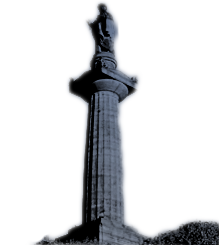Five Friends of the Glasgow Necropolis are now engaged in the massive task of indexing the burial registers from 1842 to 1995 (eventually). This covers approximately 1700 pages and comprises approximately 48000 names. In the first month (October) c220 records have either been added from scratch or expanded.
It seemed to me that it might be interesting to mention some of the discoveries that are already being made and discuss a few of the queries that have been raised as the indexers familiarise themselves with the task ahead.
One of the most striking things about the early burial registers is the number of burials which occurred in Single Graves, more usually referred to elsewhere as common graves. In the early years of the Necropolis roughly two thirds of interments were in Single Graves. Between 1833 and 1842 this means that 2625 out of 3878 persons were buried in single Graves and, as a result, are not commemorated on a grave stone. It will be very interesting to see what the final total for burials in Single Graves is by the time they are phased out in 1872. I wonder whether the final figure might be 8000 – 9000 but whatever it turns out to be it is so important to remember that none of these persons have any sort of commemorative stone in the Necropolis and are completely overlooked by visitors to the cemetery. In fact we are not even sure where the Single Graves are. We know, from the burial registers, that there are Single Graves in most of the early compartments opened in the Necropolis but we don’t know exactly where. Two years ago the Friends managed to raise money which allowed some geophysical surveys to be carried out within the most likely areas but the results were inconclusive and we are no further forward.
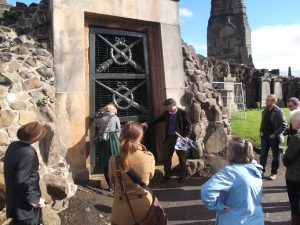
The entrance to the Egyptian Vault in 2013 after renovation
Amongst the interments that occurred in 1842 was that of Major Archibald Douglas Monteath on 21st June 1842. This page is very faint and certain details have been redone in a different hand so it is definite that Major Archie was buried in Upsilon 2; but the Egyptian Vault is also recorded as his place of burial. This was a vault used for the temporary storage of coffins until a permanent place of burial had been prepared which sometimes involved excavations and/or building work. Major Archie was unmarried and had more money than sense. He left £5000 for the construction of his monument and has bequeathed to us the Monteath Mausoleum one of the most iconic monuments in the Necropolis.
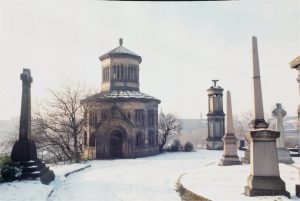
The Monteath Mausoleum
Another entry found was for the 17th burial, the stillborn son of Mr Schwabe, in what is described as the Jews Ground (also numbered Alpha 1). The Jewish community in Glasgow purchased a piece of ground in the Necropolis from the Merchants’ House and the first entry in the burial register, on 12th September 1832, is that of Joseph Levi, jeweller in Alpha 1.
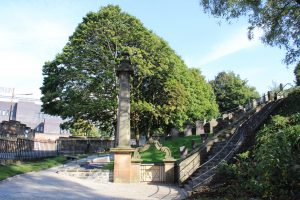
Jewish Burial Ground
In 2015 funds were obtained for the renovation of the Jewish Burial Ground and a memorial stone to the 57 persons buried there was unveiled (below).

Jewish Burial Ground – memorial stone
I myself am not transcribing the burial registers in the same manner as the rest of the volunteers. Instead I am making use of my access to the registers to try and fill in some gaps that exist in the database. I have been aware for many years that when the original Wellington Street UP Church was sold and demolished the bodies buried in the crypt were removed to the Necropolis and reburied in a large plot in compartment Alpha. It turns out that the burial registers record the number of coffins from Wellington Street Church reburied in each of 120 new graves within Alpha 85 in the Necropolis in 1879. I calculate that a minimum of 708 bodies were removed and reinterred. None of these people are identifiable unless a stone was subsequently erected on the new grave which named them. In a small number of cases burials continued in these graves but this soon ceased.
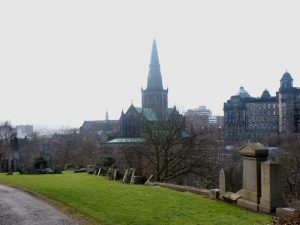
Compartment Alpha, Lair 85
Written by Morag T Fyfe, Historical and Genealogical Researcher Friends of Glasgow Necropolis









